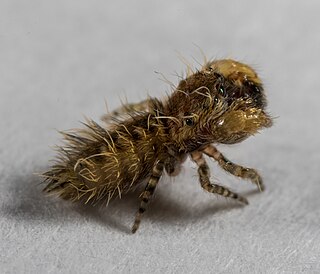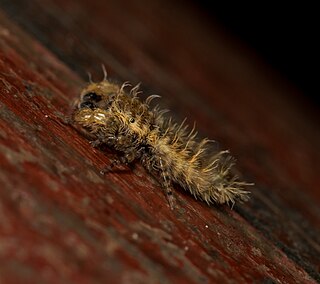
The Thomisidae are a family of spiders, including about 175 genera and over 2,100 species. The common name crab spider is often linked to species in this family, but is also applied loosely to many other families of spiders. Many members of this family are also known as flower spiders or flower crab spiders.

Wolf spiders are members of the family Lycosidae, from the Ancient Greek word "λύκος" meaning "wolf". They are robust and agile hunters with excellent eyesight. They live mostly in solitude and hunt alone, and do not spin webs. Some are opportunistic hunters pouncing upon prey as they find it or even chasing it over short distances. Some wait for passing prey in or near the mouth of a burrow.

Huntsman spiders, members of the family Sparassidae, are known by this name because of their speed and mode of hunting. They are also called giant crab spiders because of their size and appearance. Larger species sometimes are referred to as wood spiders, because of their preference for woody places. In southern Africa the genus Palystes are known as rain spiders or lizard-eating spiders. Commonly they are confused with baboon spiders from the Mygalomorphae infraorder, which are not closely related.

Latrodectus is a broadly distributed genus of spiders with several species that, together, are referred to as true widows. This group is composed of those often loosely called black widow spiders, brown widow spiders, and similar spiders. However, such general "common names" are of limited use as the diversity of species is much greater. A member of the family Theridiidae, this genus contains 32 species, which include several North American "black widows". In addition to these in North America are also the red widow Latrodectus bishopi and the brown widow Latrodectus geometricus, which, in addition to North America, has a much wider geographic distribution. Elsewhere, others include the European black widow, the Australian redback black widow, several different species in Southern Africa that can be called Button spiders, and the South American black widow spiders. Species vary widely in size. In most cases, the females are dark-coloured, but some may have lighter bodies or even reddish. Many can have red, white or brown markings on the upper-side (dorsal) of the abdomen. Some can be readily identifiable by reddish markings on the central underside (ventral) abdomen, which are often hourglass-shaped.

Orb-weaver spiders are members of the spider family Araneidae. They are the most common group of builders of spiral wheel-shaped webs often found in gardens, fields and forest. "Orb" can in English mean "circular", hence the English name of the group. Araneids have eight similar eyes, hairy or spiny legs, and no stridulating organs.

Velvet spiders are a small group of spiders almost entirely limited to the Old World, with exception of a few species known from Brazil. The characteristics of this family of spiders are that they are entelegyne, eight-eyed araneomorph spiders that build unkempt webs. They are cribellate. Some species are nearly eusocial, lacking only a specialized caste system and a queen. They cooperate in brood rearing, unlike most other spiders except for some African agelenid spiders in the genus Agelena and a few others.

Araneus is a genus of common orb-weaving spiders. It includes about 650 species, among which are the European garden spider and the barn spider. The genus was erected by Carl Alexander Clerck in 1757.
Alfenus is a genus of jumping spiders.

Uroballus is a spider genus of the jumping spider family, Salticidae. It includes five or six accepted species.

Idiopidae, also known as armored trapdoor spiders, is a family of mygalomorph spiders first described by Eugène Simon in 1889. They have a large body similar to tarantulas.

Nemesiidae, also known as funnel-web trapdoor spiders, is a family of mygalomorph spiders first described by Eugène Simon in 1889, and raised to family status in 1985. Before becoming its own family, it was considered part of "Dipluridae".

Migidae, also known as tree trapdoor spiders, is a family of spiders with about 100 species in eleven genera. They are small to large spiders with little to no hair and build burrows with a trapdoor. Some species live in tree fern stems. They have a Gondwanan distribution, found almost exclusively on the Southern Hemisphere, occurring in South America, Africa, Madagascar, Australia, New Zealand and New Caledonia.

Periegops is a genus of spiders with six eyes instead of the usual eight. It is the only genus in its family (Periegopidae) and has three described species. It was long considered to be members of Sicariidae or Segestriidae until Raymond Forster elevated them to the family level in 1995.
Uroballus peckhami is a spider species of the jumping spider family, Salticidae that is known only from northern Vietnam.

Tarantulas comprise a group of large and often ″hairy″ spiders of the family Theraphosidae. Currently, about 1,000 species have been identified. The term tarantula is usually used to describe members of the family Theraphosidae, although many other members of the same infraorder (Mygalomorphae) are commonly referred to as "tarantulas" or "false tarantulas". Some of the more common species have become popular in the exotic pet trade. Many New World species kept as pets have urticating hairs that can cause irritation to the skin, and in extreme cases, cause damage to the eyes.

Trachelidae is a family of araneomorph spiders first described by Eugène Simon in 1897 as a subfamily called "Tracheleae". The Trachelidae family, also known as "ground sac spiders", is within the group of spiders known as the RTA clade, which includes mostly wandering spiders that do not use webs. Spiders in the Trachelidae family are characterized as being 3-10mm long and having a red cephalothorax and a yellow/tan abdomen. They are commonly found indoors. It was placed in the family Clubionidae, then later in Corinnidae when the Clubionidae were split up. The first study that suggested Trachelidae should be considered its own family was done by Deeleman-reinhold in 2001 as part of an analysis of RTA Clade spiders. An analysis by Martín J. Ramírez in 2014 suggested that it was not closely related to other members of the Corinnidae, and was better treated as a separate family. It was then placed in the CTC clade of spiders, or the Claw Tuft Clasper clade, which is a group of spiders that have two tarsal claws with tufts of hair.
Uroballus henicurus is a species of spider of the genus Uroballus. It is endemic to Sri Lanka.
Uroballus kinabalu is a species of spider of the genus Uroballus. It is endemic to the Malaysian part of Borneo.
Uroballus koponeni is a species of spider of the genus Uroballus. It is endemic to the Malaysian part of Borneo.

Uroballus carlei is a species of spider of the genus Uroballus. It has only been found in Hong Kong.














